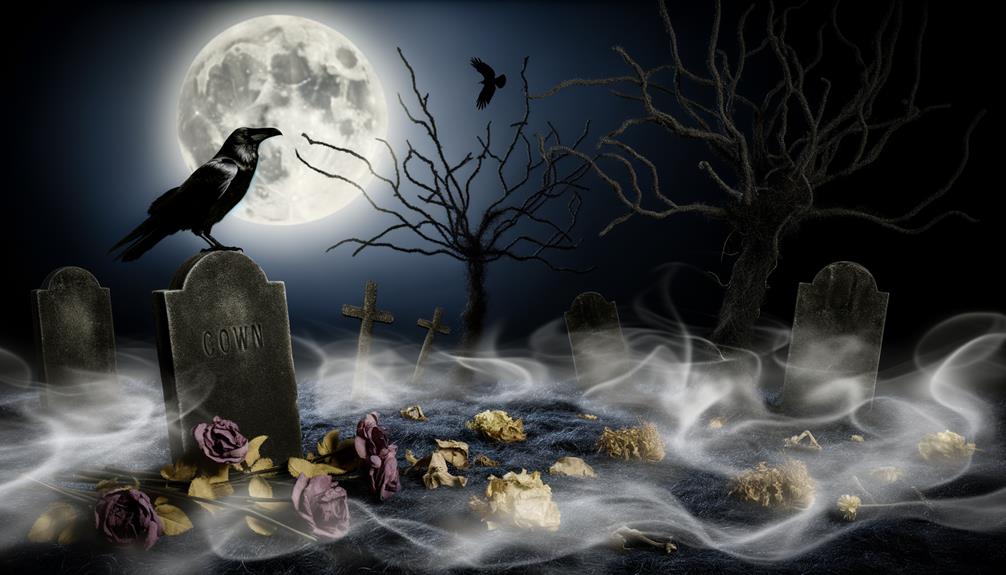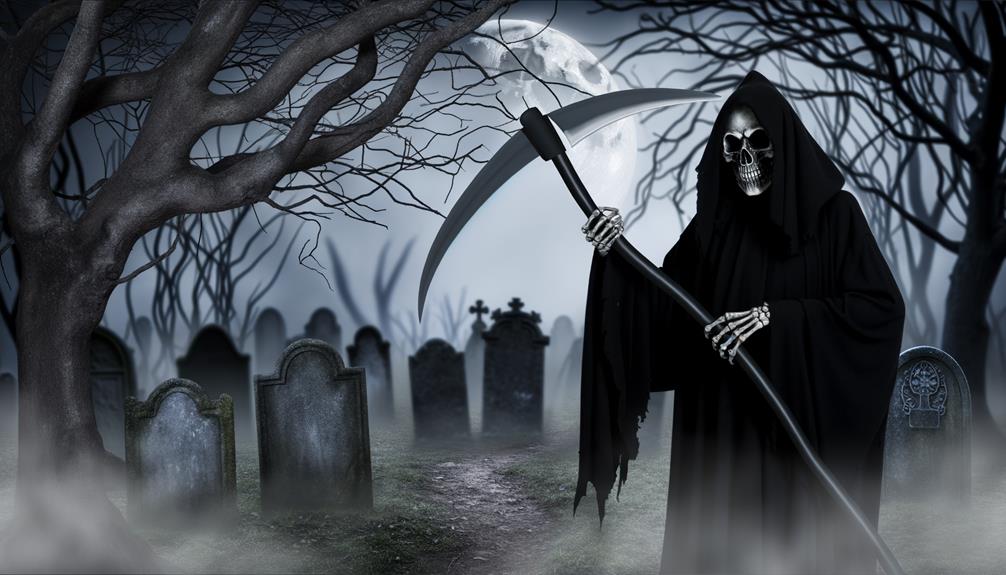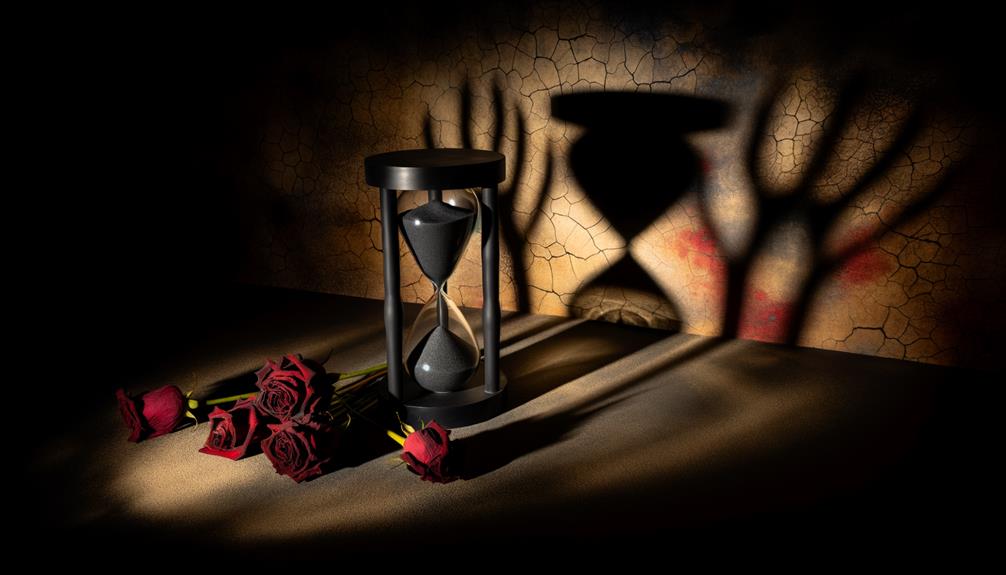Identifying Universal Symbols of Death
Symbols of death are deeply embedded in cultural narratives and iconography across the world. The Grim Reaper, often depicted as a cloaked figure with a scythe, represents the impartial nature of mortality.
The skull and crossbones signify danger and mortality and are used in diverse contexts from pirate flags to poison warnings. Black cats, though considered omens of misfortune in Western cultures, are symbols of good luck in Japan.
Ravens and crows are harbingers of death in many mythological traditions. The hourglass serves as a potent reminder of life's fleeting nature.
Understanding these symbols can offer profound insights into humanity's perception of death.

Key Takeaways
- The Grim Reaper symbolizes the impartial and inevitable nature of mortality.
- The Skull and Crossbones represent danger and the inevitability of death.
- Black Cats are often associated with death and misfortune in various cultures.
- Ravens and Crows are seen as harbingers of death in many mythologies.
- The Hourglass symbolizes the irreversible passage of time and life's fleeting nature.
Grim Reaper

The Grim Reaper, an archetype of death across various cultures, symbolizes the inevitable and impartial nature of mortality through its iconic depiction as a cloaked figure wielding a scythe.
Historically, this figure serves as a memento mori, reminding individuals of life's finite nature. The scythe, traditionally used for harvesting crops, metaphorically represents the Reaper's role in severing the soul from the body.
This imagery transcends cultures, appearing in Western folklore, where it is often depicted as a skeletal figure, and in Eastern traditions, where similar entities like the Hindu god Yama preside over death.
Such cross-cultural representations highlight the universal human preoccupation with death and the afterlife, illustrating a common thread in the human experience of grappling with mortality.
Skull and Crossbones
Among the most recognizable symbols of death, the skull and crossbones has a storied history that spans various cultures and epochs, serving as a potent emblem of mortality and danger. Its unmistakable imagery has been employed in various contexts, each carrying its own connotations:
- Pirates: Historically, pirates hoisted the skull and crossbones on their Jolly Roger flags to instill fear and signal imminent death to their adversaries.
- Poison Labels: In the world of toxic substances, the symbol warns of deadly hazards, emphasizing the lethal consequences of improper handling.
- Military and Secret Societies: Various military units and secret societies, like the Skull and Bones at Yale, adopt this symbol to convey notions of power, secrecy, and the inevitability of death.
This multifaceted emblem therefore transcends cultural boundaries, encapsulating universal themes of peril and mortality.
Black Cats

Black cats, often enveloped in an aura of superstition and mystery, serve as potent symbols of death and misfortune across various cultures and historical periods. In Western folklore, these enigmatic creatures are frequently associated with witchcraft and dark omens, stemming from medieval European beliefs where they were thought to be witches' familiars.
Contrarily, in Japanese culture, black cats can symbolize good fortune, illustrating a dichotomy in their symbolic interpretations. In ancient Egypt, the black cat was revered, linked to the goddess Bastet, protector of the home and symbol of fertility.
This cross-cultural comparison highlights the fluidity of symbols, where the black cat's association with death and misfortune is not universal but deeply rooted in specific historical and cultural contexts.
Ravens and Crows
Ravens and crows have long been intertwined with themes of death across various cultures, serving as potent symbols in mythological narratives from Norse to Native American traditions.
These birds often appear as omens, their presence interpreted as harbingers of misfortune or death.
Such symbolic roles underscore their cultural significance and the universal human tendency to imbue the natural world with metaphysical meaning.
Mythological Significance
Exploring the mythological significance of ravens and crows reveals their profound symbolic roles in various cultures, often embodying themes of death, transformation, and prophecy.
In Norse mythology, Odin's ravens, Huginn and Muninn, symbolize thought and memory, acting as divine messengers.
In Native American lore, the raven is a creator and a trickster, signifying transformation and the thin veil between life and death.
Similarly, in Celtic mythology, the crow is associated with the Morrigan, a goddess of battle and fate.
These avian symbols transcend cultural boundaries, illustrating universal themes of mortality and change.
Omens and Superstitions
Interpreting the omens and superstitions surrounding ravens and crows reveals a tapestry of beliefs that highlight their roles as harbingers of death, guardians of the afterlife, and symbols of misfortune across various cultures.
In European folklore, these dark birds are often seen as ominous, their presence foretelling death or disaster. The Norse mythology associates ravens with the god Odin, symbolizing wisdom but also the constant presence of death.
Conversely, in some Native American traditions, crows serve as messengers between the living and the dead, offering protection. This duality underscores their complex symbolism, functioning both as warnings and as spiritual guides.
Therefore, ravens and crows encapsulate humanity's intricate relationship with mortality and the unknown.
Cultural Symbolism
In examining the cultural symbolism of ravens and crows, it becomes evident that these birds have been imbued with profound and multifaceted meanings across diverse societies. Their presence often evokes associations with death, transformation, and the supernatural.
- Norse Mythology: Ravens, seen as Odin's messengers, symbolize wisdom and foreknowledge, often linked to the valkyries and the battlefield.
- Native American Beliefs: Crows and ravens are regarded as tricksters and shape-shifters, embodying the boundary between life and death.
- Medieval Europe: These birds were seen as omens of death and were often depicted in art and literature as harbingers of doom.
Through these varied lenses, ravens and crows illustrate the complex interplay between cultural beliefs and the symbolism of death.
Hourglass

The hourglass, an ancient instrument for measuring time, serves as a profound symbol of life's fleeting nature and the inevitability of death across numerous cultures. Its design, with sand slipping inexorably from one chamber to the other, represents the irreversible passage of time.
In Western iconography, it often accompanies the Grim Reaper, signifying the end of life's journey. Similarly, in Eastern traditions, the hourglass reflects the Buddhist concept of impermanence. In both medieval Europe and ancient Egypt, the hourglass was associated with mortality and the transient nature of human existence.
This cross-cultural symbolism underscores a universal awareness of life's temporal constraints, reminding individuals of their mortality and the importance of living meaningfully within the confines of time.
Tombstones
Tombstones, as enduring markers of mortality, hold significant historical value and reflect evolving cultural attitudes toward death. Their artistic designs, ranging from simple inscriptions to elaborate sculptures, offer insights into societal values and religious beliefs across different eras and regions.
Historical Significance
Tracing the evolution of tombstone designs reveals profound insights into the cultural and symbolic interpretations of death across different historical periods. Tombstones serve as markers of mortality, reflecting societal values and religious beliefs.
Historically, their designs have varied considerably:
- Ancient Egypt: Elaborate stone carvings and hieroglyphics emphasized the journey to the afterlife and the preservation of the soul.
- Medieval Europe: Simple, cross-shaped stones often included iconography such as skulls and hourglasses, symbolizing the transient nature of life.
- Victorian Era: Ornate, sculpted tombstones featured angelic figures and floral motifs, embodying both mourning and hope for eternal peace.
This cross-cultural comparison underscores how tombstones transcend mere grave markers, becoming rich canvases for expressing collective human concerns about death and the afterlife.
Artistic Designs
In examining the artistic designs of tombstones, one can discern a rich tapestry of cultural symbolism and aesthetic values that reflect a society's attitudes towards death and remembrance. Tombstones serve as both markers of final resting places and artistic expressions of mourning and respect. Various symbols, such as angels, skulls, and flowers, convey distinct cultural meanings.
| Symbol | Cultural Interpretation |
|---|---|
| Angel | Guardian of the departed soul |
| Skull | Mortality and the impermanence of life |
| Flower | Transience and beauty of existence |
For instance, angels are prevalent in Western designs, often signifying protection and guidance. Skulls, common in Mexican Day of the Dead imagery, emphasize life's fleeting nature. Flowers, ubiquitous across cultures, symbolize the ephemeral beauty of life.
Ankh

The ankh, an ancient Egyptian hieroglyphic symbol, represents not merely physical life but the eternal continuity of existence, providing a profound juxtaposition to more finite symbols of death. Its unique form—a looped cross—embodies the convergence of mortal and immortal domains.
Symbolically, the ankh signifies:
- Life and Death: Balancing the cycles of existence and the afterlife.
- Divine Protection: Wielded by deities, it offers safeguarding beyond mortal confines.
- Rebirth and Regeneration: Echoing the Nile's inundation, it promises renewal.
Cross-culturally, while Western symbols like the skull convey mortality's finality, the ankh inspires contemplation of life's perpetuity. This enduring emblem underscores ancient Egypt's intricate views on death, contrasting markedly with other cultural symbols that emphasize cessation over continuity.
Dia De Los Muertos
Just as the ankh embodies the eternal cycle of life and death, Dia De Los Muertos, or the Day of the Dead, epitomizes a vibrant celebration of ancestry and memory, transforming the perception of death into an affirmation of life.
Originating in Mexico, this festival integrates pre-Columbian and Catholic traditions, symbolizing a harmonious union of indigenous and colonial cultures.
Marigolds, sugar skulls, and ofrendas (altars) serve as potent symbols, bridging the temporal divide between the living and the deceased.
Unlike Western views that often depict death as a finality, Dia De Los Muertos emphasizes continuity, underscoring that death is merely another phase in the perpetual cycle.
This cultural nuance invites a broader understanding of death as a communal and celebratory experience.
Conclusion
The exploration of symbols associated with death reveals a rich tapestry of cultural and historical interpretations. From the Grim Reaper to the Ankh, these symbols provide a visual representation of mortality and the human condition.
Cross-cultural comparisons highlight both unique and universal elements in how societies perceive and ritualize death. This symbolic analysis underscores the significance of death as a profound and unifying aspect of human experience, transcending individual cultures and epochs.





